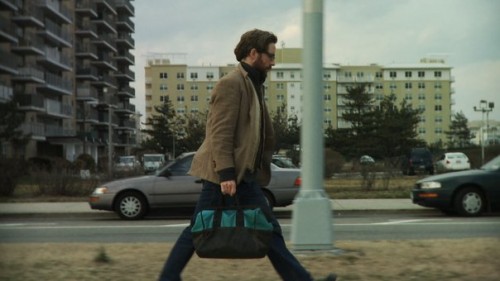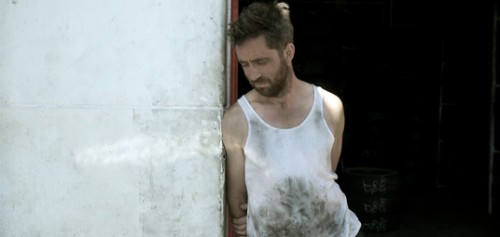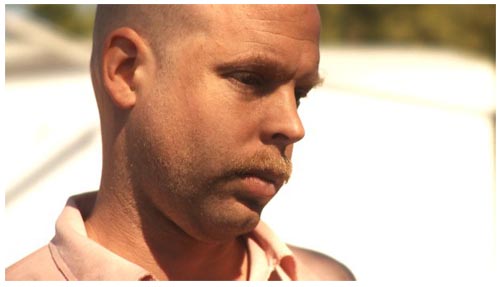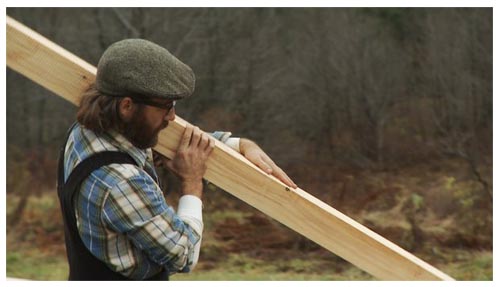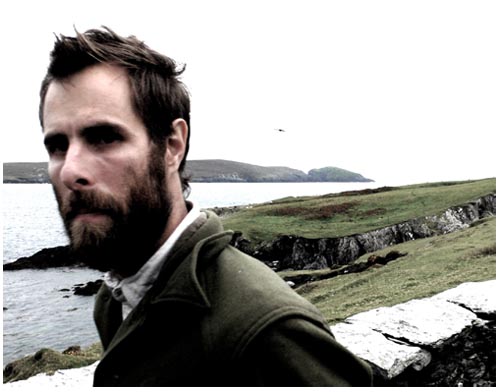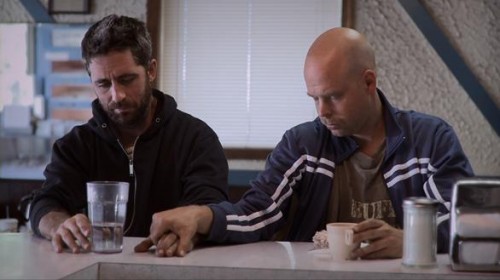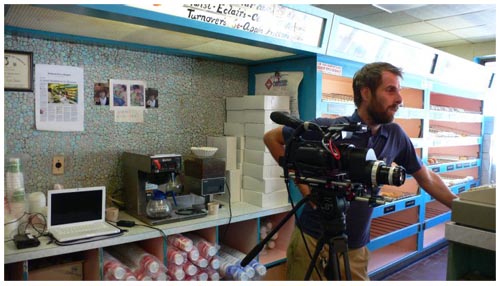Entrevista a Rick Alverson
“(…) lo que realmente nos hará hallar el equilibrio es la contradicción, nuestro opuesto”
Click here for the English version
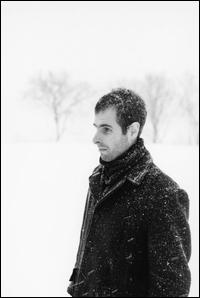 Conocimos a Rick Alverson durante el pasado Festival de Róterdam en 2011. Su carta de presentación fue allí New Jerusalem, su segundo largometraje tras debutar con The Builder. Claramente el otro reclamo del filme era Will Oldham, a quien habíamos seguido como músico. Nos sentimos tocados por la honesta mirada del director y su inquietud por comprender algo tan misterioso como la fe. Tras la proyección, tres hombres delgados y barbudos respondieron a las preguntas de la audiencia en el patio de butacas: Alverson, Oldham y el protagonista de los dos filmes del director, Colm O’Leary. Regresamos a España y quisimos seguirle la pista al realizador de Richmond. La siguiente entrevista tuvo lugar este verano a través de correo electrónico.
Conocimos a Rick Alverson durante el pasado Festival de Róterdam en 2011. Su carta de presentación fue allí New Jerusalem, su segundo largometraje tras debutar con The Builder. Claramente el otro reclamo del filme era Will Oldham, a quien habíamos seguido como músico. Nos sentimos tocados por la honesta mirada del director y su inquietud por comprender algo tan misterioso como la fe. Tras la proyección, tres hombres delgados y barbudos respondieron a las preguntas de la audiencia en el patio de butacas: Alverson, Oldham y el protagonista de los dos filmes del director, Colm O’Leary. Regresamos a España y quisimos seguirle la pista al realizador de Richmond. La siguiente entrevista tuvo lugar este verano a través de correo electrónico.
– Algunos temas desarrollados en New Jerusalem (p. ej., el debate motivado por la intervención de EE.UU. en guerras recientes o un protagonista masculino solitario que carga con una profunda crisis existencial) estaban esbozados en tu primera película, The Builder. Nos gustaría que nos hablases un poco de este tipo de inquietudes y, en concreto, de esa desconexión con el mundo que sufren ambos protagonistas interpretados por Colm O’Leary.
Tanto Colm como yo sentimos especial interés por la experiencia de los inmigrantes y por cómo a través de ella se retrata la idea de qué es Estados Unidos. New Jerusalem en un principio se llamaba The American (El americano) y probablemente debería haberse mantenido con ese título… Mis dos películas examinan un ideal y cómo este naufraga en la vida del día a día, pero también tratan de observar si ese ideal conlleva o no acciones constructivas, si realmente es sinónimo de felicidad, si es siquiera conveniente. La ciudad de Nueva Jerusalén es una utopía como también lo es la idea de Estados Unidos, pues ambas son falsos dioses… De todas maneras, la auténtica cuestión aquí es: ¿esa inalcanzable ciudad de la montaña nos es más destructiva que beneficiosa o nos beneficia más que nos destruye?
– Procedes del campo de la composición musical, pero ahora has iniciado una carrera como cineasta… ¿Cómo y cuándo sentiste la necesidad de expresar temas y sentimientos a través de las imágenes? ¿Qué diferencias observas entre ambas formas de expresión artística y en relación a tu aproximación a ellas?
Pienso las películas de manera musical, así que me aproximo a ellas a través de la tonalidad. Cada vez me interesa menos lo que se dice y me fijo más en cómo se dice. Las diferencias formales que existen entre la concepción y la interpretación en música y cine hacen que sean mundos aparte… En parte, echo de menos la simpleza de acercarme la guitarra al pecho y que todo fluya.
– En tan solo dos películas, como espectadores podemos ya identificar varias marcas que pretenden definir un estilo específico y personal: el particular uso de la música, la presencia del desenfoque, los cortes bruscos en negro, la importancia de los primeros planos cerrados… Al mismo tiempo ambas contienen un estilo austero e incluso minimalista, donde los recursos citados acentúan el tono grave… ¿Cómo afrontas el proceso de planificación? ¿Procuras tener todo atado para el rodaje o realmente dejas que la película se construya durante el mismo como una especie de work in progress?
Rodamos las películas improvisando en los temas formales y en los diálogos. Las escenas están formadas por bloques y las tomas largas se deciden con antelación, pero la interacción entre los actores es espontánea, ya que así es como ellos pueden llegar a hacerse con sus personajes. El resultado final de la película, en buena parte, se decidió a través del casting y luego en la sala de montaje… De hecho, creo que ya no tiene mucho sentido hacer ese tipo de películas tan profesionales y estáticas, que cuentan con guiones profundos y que están totalmente preconcebidas… ¿Dónde queda la ignorancia? ¿Dónde queda el azar que permite que la luz de la realidad se cuele en la película?
– Sobre el cuerpo de O’Leary parece descansar todo el peso del mundo, su fisicidad vulnerable y grave empapa ambos filmes. ¿Cómo surge tu relación con O’Leary? ¿Cómo lleváis a cabo la escritura de los guiones entre los dos y la relación como director e intérprete, respectivamente, durante el rodaje?
Colm y yo nos conocemos sobre todo de adultos y somos amigos íntimos. Nuestra relación siempre ha sido muy rica en ideas. Concebimos las películas como conversaciones sobre la realización de cine, la escritura y también como preguntas sobre el mundo que nos rodea, con un lugar y un objetivo concreto, sobre la relación de cada cual con su alrededor. Ambos sentimos cierta desconfianza hacia los medios. Creo que (el audiovisual) es un elemento clave para una realización cinematográfica constructiva. En cuanto al proceso: la ficción debería ser creada, en primer lugar, a mi lado de la cámara, a través del argumento, de la filmación, la edición y del montaje de las imágenes y los sonidos. Así es como he podido observar la presencia de Colm, su valentía, su firmeza y su vulnerabilidad. Todo ello debería llegar al espectador sin manipulaciones, todas esas contradicciones deberían estar presentes porque, si es una interpretación honesta, se resolverán en el cuerpo y en los gestos del actor.
– En ambas películas, hay un cuidado trabajo de ambientación sonora. Además de las referencias musicales, utilizas un amplio y variado registro de sonidos de la naturaleza. ¿Cómo afrontas la elaboración de la banda sonora?
El sonido se grabó en las localizaciones, mientras rodábamos. Había sonido directo y creo que era la mejor opción, aunque en producciones grandes es más difícil de conseguir.
– The Builder se centra en un solo hombre, un único protagonista, mientras que New Jerusalem baila entre dos tipos que representan dos puntos de vista a priori antagónicos y el intento de aproximación entre ambos mundos, perspectivas… ¿Cómo surgió el argumento de New Jerusalem, donde la religión se sitúa en el punto de mira?
Colm y yo estábamos interesados en la necesidad de la amistad, en su utilidad, sobre todo cuando se da en las relaciones más insólitas. Hay una confianza simbiótica y una necesidad mutua entre los dos personajes masculinos, los cuales, aunque se expresan de manera tranquila, de alguna manera también son muestras de desesperación. Muy a menudo buscamos en el otro aquello que nos falta, pero con frecuencia no sabemos que lo que necesitamos, lo que realmente nos hará hallar el equilibrio, es la contradicción, nuestro opuesto.
– Como admiradores de la faceta musical de Will Oldham, nos intriga también mucho cómo surgió vuestra relación y cómo trabajáis juntos. Suponemos que le conocías antes de su intervención en Old Joy. ¿No es así?
Will fue lo suficientemente amable como para aceptar trabajar conmigo en base al interés que le despertó The Builder después de que se la enviara. Admiro su trabajo desde la primera vez que le oí, y a partir de entonces me interesé en saber más de la personalidad que había detrás de aquella obra. El personaje de Ike acaba haciéndolo suyo, pues la historia se convierte en la interpretación que Oldham nos brinda de ese hombre y sus contradicciones.
– La canónica figura del errante parece planear sobre The Builder (Walden de Thoreau, Centauros del desierto de Ford, París, Texas de Wenders y referentes que haces explícitos: Whitman, Griffith…). ¿Hasta qué punto consideras relevante tu vínculo con la tradición literaria y cinematográfica? ¿Crees que es necesaria esa revisitación para actualizarla al mundo en el que vivimos?
Veo el vínculo entre películas, literatura y teatro, pero estoy totalmente de acuerdo con Bresson cuando dice que las conexiones deberían romperse siempre que sea posible. Creo que por eso el tono de la película es más interesante que su contenido, porque el cine tiene la capacidad única de captar el tiempo, las sutilezas, los matices, el tono y la contradicción de una manera en que ni la literatura ni el teatro, al contar solo con el punto de vista de un individuo, pueden. La cámara y el micrófono son fantásticos porque nos son indiferentes, tanto a nosotros como al protagonista. Son como parte del mundo natural. En lo que se refiere al deambular, reconozco que me interesa su tradición en el arte norteamericano. Creo que es la herencia de ese ideal grande y utópico de la universalidad de la democracia y la igualdad, del que muy poco se ha logrado alcanzar, ya que el pueblo parece propenso a la holgazanería y la mediocridad. Ese ideal nos aporta comodidad y seguridad, pero no es saludable ni nos acerca a la paz interior, porque estas cualidades parecen inalcanzables para el americano medio que el ideal genera como modelo: el hombre obeso y vago. ¿Acaso podemos alcanzar el ideal en colectividad? Nuestro estado espiritual se ve boicoteado y ligado a objetivos que están puestos más allá del mundo natural interpretable, por lo que acaba por parecer que es propenso a deambular como un fantasma que ansía un cuerpo, que ya no puede ocupar, o un Cielo, que no se encuentra.
– En algunas secuencias aisladas, además de integrar el sonido de una caja de música en la banda sonora, los protagonistas hallan algo de alivio en instantes donde parecen retrotraerse a la infancia (observando el juego de unos niños o determinados objetos, hablando con un sobrino…). La imposibilidad de recuperar la inocencia/levedad de aquella etapa parece afligirles y el final se impone como una interrupción en cierto grado desoladora. ¿Cómo decidiste cerrar así tus filmes y qué pretendías en un principio despertar en el público?
Encuentro que los finales de las películas son un poco vergonzantes, y es que son un engaño. Por un lado existen los deseos y por el otro sus contradicciones; existe la nostalgia y existe la rendición. Aquellos finales victoriosos de Hollywood que me envenenaron de niño son tan solo triunfos temporales y arrogantes.
– En tus dos películas el protagonista parece ir en busca de una revelación, de algo que dé sentido a su existencia. En New Jerusalem se le plantea la opción cristiana pero él parece incapaz de creer en ella… ¿Qué es lo que da sentido a nuestras vidas en la era de la posmodernidad?
La utilidad, la comprensión de las limitaciones de un cuerpo concreto y de un lugar concreto, y aprender a vivir plenamente en ese cuerpo y en ese lugar.
– En 2.17.09, uno de tus primeros cortometrajes rodado en una planta hidroeléctrica de Richmond, filmas ya “naturalezas muertas”… Un hábito también presente en tus dos largometrajes -planos de sillas, de llantas, de ruedas, de manchas de petróleo, de objetos de porcelana… ¿Qué buscas captar recurriendo a ese tipo de imágenes?
Se trata de las condiciones estáticas que nos rodean, en las cuales nosotros clavamos la mirada de manera literal. Son neutrales, pero están en proceso de descomposición; de hecho, hay mucho que aprender sobre ese punto de vista y sobre ese estado.
– New Jerusalem es una película constituida en base a conversaciones entre dos personajes. En ellas no recurres al tradicional plano/ contraplano y te sitúas muy cerca de los personajes… ¿Qué implica filmar un diálogo? ¿Cómo afrontaste este reto en tu segunda película? ¿Qué tipo de indicaciones das a los actores?
De nuevo, el guión no tenía diálogo y solo dábamos directrices en algunas ocasiones. Tanto el tono como lo que transmiten los personajes se establecen en la mayoría de los casos a partir de los cortes y la duración. Creo firmemente en la espontaneidad y la incertidumbre que las conversaciones y las interacciones tienen en la vida. En mi opinión, cuantos más impedimentos pongamos a esa naturalidad y a ese flujo peor será para la película. El trabajo es para explorar y evaluar cualquier tipo de vida en el objeto. No entiendo por qué construimos ficciones y esperamos que se asemejen a la vida y a la realidad. La realidad es desordenada e imperfecta, turbia y contradictoria, y su significado en rara ocasión puede expresarse en palabras, pero se hace evidente en el espacio intermedio. La ficción debería ser la excepción, un cebo inusual para lo real.
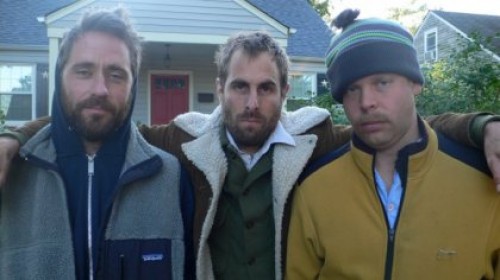
– The Builder y New Jerusalem forman parte de un proyecto de varias películas llevado a cabo por la discográfica Jagjaguwar. ¿Nos podrías contar cómo ha surgido este proyecto y qué aspiraciones tiene? ¿Qué presupuestos manejas para tus trabajos y qué posibilidades tienen de ser estrenados comercialmente?
He tenido una larga y fructífera relación con Jagjaguwar. Les he visto crecer, de ser un sello casero a convertirse en una de las firmas discográficas más relevantes del mundo en la actualidad. Les considero amigos cercanos y me siento en deuda con ellos por el apoyo y la confianza que han depositado en mi obra. Chris Swanson, uno de los dueños, ha aumentado todavía más el compromiso del sello con el desarrollo de los artistas y en ese aspecto no hace diferencias con la rama del cine. El presupuesto para la película era entre mínimo e ínfimo, pero aun así era una inversión. The Builder la distribuyó Jagjaguwar y está disponible en DVD y en streaming por internet. New Jerusalem está en proceso de negociación para estrenarse en salas. En colaboración con Jagjaguwar rodé la pasada primavera otra película, Rabbit, de nuevo con Colm O’Leary y Will Oldham, la cual llevaremos de festivales a principios de 2012. También me ha financiado el drama The Comedy, que rodaré el próximo mes [agosto 2011] y que cuenta con Tim Heidecker y Eric Wareheim, conocidos por Tim and Eric. Además estamos desarrollando una película llamada Clement basada en una historia de Colm O’Leary que protagoniza él mismo, una película ambientada en el año 1870, tras la guerra civil, en la zona rural de Virginia. Para estos dos últimos trabajos hemos contado con el productor Mike S. Ryan (Meek’s Cutoff, Palindromes, Life After Wartime).
– ¿Qué opinión te merece el cine contemporáneo? ¿Dónde te sitúas como autor dentro del cine estadounidense actual? ¿Sientes simpatía por realizadores como Kelly Reichardt o por los miembros del movimiento “mumblecore”?
Es prometedor, como una película que vi ayer noche y que me encantó: Aurora, de Cristi Puiu. La pianista de Michael Haneke aún me persigue después de diez años de haberla visto y posiblemente sea una de mis películas favoritas. O como el trabajo de Bruno Dumont, Claire Denis, Gaspar Noé, Gotz Speilmann y Harmony Korine… Siempre he respetado el trabajo de Kelly Reichardt, ha sido una especie de barómetro para mí, ya que tenemos una sensibilidad similar y ambos hemos trabajado con Oldham… Casualmente, además, estoy trabajando en The Comedy con Glass Eye Pix, la productora que lleva Larry Fessenden, quien ha producido y trabajado con Reichardt a lo largo de su carrera. Conocí a Joe Swanberg en el SXSW este año y congeniamos enseguida; siento mucho respeto por esa firme ambición que tiene. En lo que a mí respecta, dejo que los demás juzguen qué lugar tengo en este ámbito, y si soy suficientemente afortunado para tener un lugar en esto.
Traducción del inglés: Mónica Jordan Paredes
“We are often unaware that what we need, what will balance us, is the contradiction, the opposing characteristic”
We met Rick Alverson on 2011 Rotterdam Film Festival. He was presenting New Jerusalem, his second feature after his debut, The Builder. Will Oldham, whose career as musician we’ve been following carefully, was there too. We felt touched by Alverson’s honesty, by his point of view and his interest on trying to understand the mystery of faith. After the movie, the three thin bearded men answered the audience questions: Alverson, Oldham and the main actor in both Alverson’s movies, Colm O’Leary. So, when we came back to Spain we wanted to follow that thread and know a little more about the Richmond’s filmmaker. This interview was made through e-mail on summer 2011.
– Some topics treated in New Jerusalem (as the debate concearning the USA interventional politics in recent wars, or the lonely man having a deep existential crisis) were outlined in The Builder. Could you tell us about these worries that recur on your movies? We’re really interested on Colm O’Leary characters’ lack of contact with the world.
Colm and I have a particular interest in the immigrant experience and how it frames the idea of America. New Jerusalem was originally called The American and likely should have remained so. Both pictures examine an ideal and how that ideal is folded into everyday life, whether or not it fuels constructive actions, whether it is really synonymous with happiness, if it is even desireable at all. New Jerusalem is a utopia like the idea of America, both are “false gods” – but, the question is – is that unacheivable “city on the hill” more destructive than beneficial to us?
– You come from musical field and you have also started a career as a filmmaker. How and when did you feel the need to express yourself by using images? What differences do you notice among them and on your approach to both?
I think of movies musically. I approach them tonally. I have less and less interest in what is said and more interest in how it is said. As for the formal differences in conception and rendering of these things they are worlds apart. I miss the simple act of lifting a guitar to my chest and the thing is done.
– Even with only two movies, we can easily identify several marks/guides that define your style: a particular use of music, takes out of focus, sudden cuts to black, the relevance of close-ups… At the same time, though, both films are minimalistic and all those elements are used to emphasise loneliness… How do you face up the planning? Do you have everything tied for the shooting or you prefer the “work in progress” way?
The films are made from formal treatments with unscripted dialog. Scenes are blocked and larger tones are decided in advance, but the exchanges are spontaneous and the cast truely inhabits the characters and is allowed to do so. A lot occurs in the editing and casting. I think there is little sense anymore to the static punditry of wholely pre-conceived, heavily scripted movies- where is the ignorance in it? Where is the accident and the crack in the thing that lets the light in?
– The whole weight of the world seems to lean on O’Leary’s body; both movies become imbued with his vulnerable and solemn physique. How does your relationship with O’Leary start? How do you and Colm carry out the script’s writing, as well as your relationship as director and actor during the shooting?
Colm and I have known each other most of out adult lives, we are very close friends. Our relationship has always been most alive in ideas. The films are conceieved as conversations about filmmaking and writing and questions about the medium between us, as much as they are conversations of place and purpose and one’s relationship with their environment. We both share a real, persisting suspicion of the medium. I think that is a necessary element to constructive filmmaking. As for the process: The fiction should be created primarily on my side of the camera, through the plotting and capture and assembly of the images and sounds. I have seen that weight in Colm, as I have seen the bravery in him and the adamance and the vulnerability in him. They should come across to the audience undistorted, and all those contradictions should be present, because if it is an honest rendering they will be resolved in the subject’s body and their mannerisms.
– In both movies, there is an elegant treatment to create a particular sound atmosphere. Besides the musical references, you use a wide and varied record of nature sounds. How do you face up the soundtrack production?
All the sounds were recorded during the takes on location. They are available sound, and I think should be, although with bigger productions that becomes more difficult.
– The Builder is focused on a lonely man and there’s only one main character, whereas New Jerusalem is centered on two guys and the movie shows two different points of view. How did New Jerusalem’s plot come up, with religion as main topic?
Colm and I were interested in the necessity of friendships, their utility, esspecially the unlikely ones. There is a simbiotic reliance and mutual need between the two men. It is quiet but desperate in its way. We are often searching for what we lack, of course, but we are often unaware that what we need, what will balance us, is the contradiction, the opposing characteristic.
– We love Will Oldham’s music. We are also interested in how your relationship started up and how is been your work together. We suppose that you knew about his appearance in Old Joy.
Will was kind enough to be open to working with me base done his interest in The Builder, which I sent to him. I have admired his work since I first heard it and had been interested in the personality behind it. The character IKe is very much his as the story ultimately turns on his rendering of that man and his contradictions.
– The historical figure of the ‘wandering’ seems to plan on The Builder (Walden, The Searchers, Paris, Texas, and other explicit quotes as Whitman, Griffith …). Do you consider relevant your link with the literary and cinematographic tradition? Do you consider necessary an updating on that topic?
I see the link between movies and literature and theater but am adamantly on the side of Bresson in that that link should be severed whenever possible. I think that is why the tone of the film is more interesting than the content per say, movies are uniquly positioned to capture time and subtlety and nuances and tone and contradiction in a way that literature and theater, being explicitly the vantage of an individual, cannot. The camera and microphone are beautiful because they are indifferent to us and to the subject. They are much like the natural world that way. As for wandering, I am interested in that tradition in American art. I think it is the inheritance of that great American, utopian ideal of universal democracy and equality – in what little parcels it is acheived the populace always seems prone to lassitude and mediocrity. It is comfort and it is safety, but it is not heath, nor is it peace – these seem out of reach to the obese and idle American model of that ideal. Is it collectively acheivable? Our spiritual state, because it is spoiled and aquainted so habitually with goals beyond the capacity of the natural world to render, seems always prone to wander like the ghost desiring both a body it can no longer occupy and a conception of a heaven that is not there.
– In some specific sequences, apart from including a box of music sound, the main characters find some relief when they seem to come back to their childhood (looking children playing or looking certain objects, speaking to a nephew …). Their inability to recover the innocence seems to upset them and the end is imposed as a distressing interruption. Why did you finish your movies this way and what was the feeling you expected the audience to feel?
I find resolution in films a bit disgusting. It is a misleading. There is desire and there are the conditions we find inconsistent with that desire. There is longing and there is surrender. The triumphs of the hollywood apparatus that poisoned me as a child are only momentary triumphs, and they are arrogance.
– In your two movies the main character seems to search a revelation, something meaningful in their existence. In New Jerusalem the Christian option appears but Sean isn’t able to believe in it… What gives meaning to our lives in the postmodern era?
Utility. Understanding the limitations of a particular body and a particular place. Learning to live acutely in that body and place.
– In 2.17.09, one of your first shorts rolled in a Richmond’s hydroelectric plant, you already shot ‘still lives’… We can find that in your two full-lenght films, as well: shots on chairs, rims, wheels, oil’s spots, porcelain objects…-. What do you want to capture with these still lives?
They are the static conditions that surround us, that we stare at, literally. They are neutral, but decaying. There is a lot to learn from that sight and state.
–New Jerusalem is a movie constituted on the basis of conversations between two prominent figures. You don’t resort to the traditional shot reverse- shot cutting, but you place the camera very close to the characters… How do you approach the shoot of dialogues? How did you face up this challenge in your second movie? What kind of instructions do you give to the actors?
Again, there is no scripted dialog, barring the occasional sugestion. The tone and what is to be conveyed from one charácter to another are set as is the blocking and duration in most cases. I believe strongly in the spontanaety and uncertainty that conversations and interactions have in life. The more impediments to that uncertainty and flux, the less useful, in my opinión. The work is for exploring and gauging any type of life in the thing. I don’t understand why we build fictions and expect life-likeness and reality. The terms of reality are messy and imperfect, they are muddy and contradictory, there meaning is seldom evident in words, but always evidente in the space between. Fiction should be the exception, an abberant bait for the actual.
– The Builder and New Jerusalem are part of a bigger project, several movies carried out by the record company Jagjaguwar. Could you tell us how does this project start and which are its aspirations? What budget do you handle for your movies and what’s the odds on having them released in theatres?
I have a long, fruitful relashionship with Jagjaguwar. I have watched them grow from a bedroom label to one most relevant labels in the world today. I consider them close friends and am indebted to their support and belief in my work. Chris Swanson, one of the owners, has stressed the label’s commitment to artist development and it is no different with their branching into film. The budgets are considered micro to low, but it is still quite an investment. The Builder is distributed by Jagjaguwar and available on DVD and streaming online. New Jerusalem is in the process of negotiating theatrical distribution. In collaboration with Jagjaguwar I shot another film this past spring called Rabbit, again pairing Colm O’Leary and Will Oldham, that will see festivals early 2012. As well the label is funding a drama called The Comedy, which I am shooting next month, featuring Tim Heidecker and Eric Wareheim of Tim and Eric fame. In addition we are in development for a feature called Clement based on a story by Colm O’Leary, in which he will also play a major role, set in 1870, post civil-war, rural Virginia. We have teamed up with producer Mike S. Ryan (Meek’s Cutoff, Palindromes, Life After Wartime) for the latter two projects.
– What do you think about the contemporary cinema? Where do you see yourself as an author in the American cinema? Do you like directors as Kelly Reichardt or the «mumblecore» movement?
It is very promising. A film called Aurora by Cristi Puiu that I saw last night and loved. The Piano Teacher by Michael Haneke, which still resonates for me 10 years later and is easily one of my favorite films of all time. The work of Bruno Dumont and Claire Denis and Gaspar Noe and Gotz Speilmann and Harmony Korine. I have always respected Kelly Reichardt’s work , it has been a kind of barometer for me as we share some sensibilities and have both worked with Oldham, etc. Coincidentally, I am working with Glass Eye Pix on The Comedy, a production company run by Larry Fessenden who has produced and worked with Reichardt throughout her career). I met Joe Swanberg at SXSW this year and felt a kindship with him and have a lot of respect for his unwavering ambition. As for myself, I’ll let others be the judge of my place in the field, if I am fortunate enough to have one.

